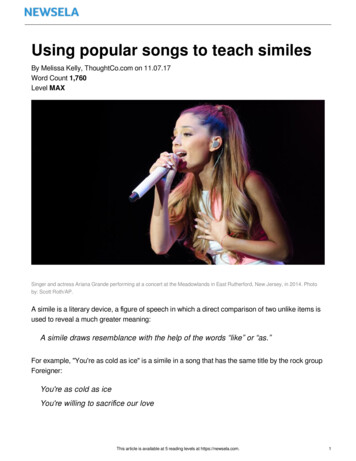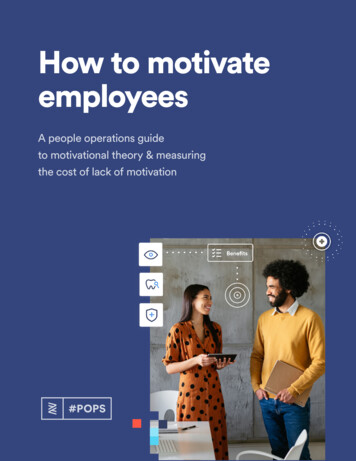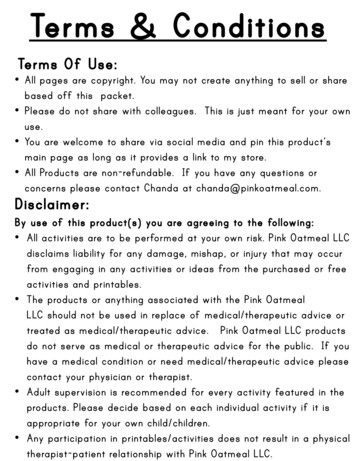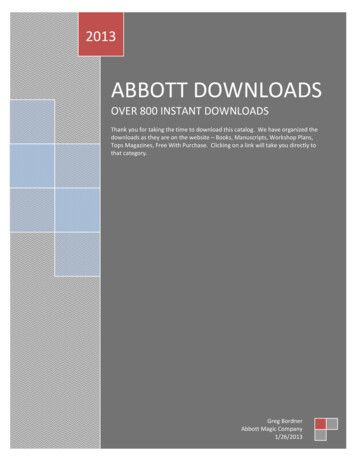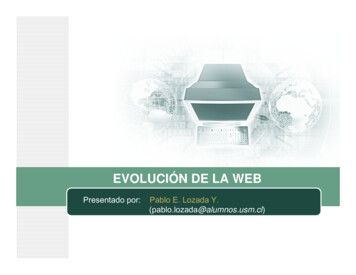
Transcription
Centers for Disease Control and PreventionNational Center for Immunization and Respiratory DiseasesEpiVac Pink Book Web-on-Demand SeriesGeneral Best Practices Part 2, and Vaccine Safety-2020Immunization Services DivisionNational Center for Immunization and Respiratory DiseasesCenters for Disease Control and PreventionAtlanta, GAPhotographs and images included in this presentation are licensed solely for CDC/NCIRD online and presentation use. No rights are implied or extended for use in printing or any use by other CDC CIOs or any external audiences.
Learning Objectives For each vaccine-preventable disease, identify those for whom routine immunizationis recommended. For each vaccine-preventable disease, describe characteristics of the vaccine used toprevent the disease. Describe an emerging immunization issue. Locate current immunization resources to increase knowledge of team’s role inprogram implementation for improved team performance. Implement disease detection and prevention health care services (e.g., smokingcessation, weight reduction, diabetes screening, blood pressure screening,immunization services) to prevent health problems and maintain health.
Today’s AgendaEpiVac Pink Book Web-on-Demand Series:General Best Practices Part 2, and Vaccine Safety-2020Andrew Kroger, MD, MPH, Medical Officer, CDC/NCIRD
Continuing Education Information CE credit, go to: www.cdc.gov/GetCE Search course number: WD4344-071520 CE credit expires: July 1, 2022 CE instructions are available on the EpiVacPink Book Web-on-Demand Series web page Questions and additional help with theonline CE system, e-mail CE@cdc.gov
Disclosure StatementsIn compliance with continuing education requirements, all presenters must discloseany financial or other associations with the manufacturers of commercial products,suppliers of commercial services, or commercial supporters, as well as any use ofunlabeled product(s) or product(s) under investigational use.CDC, our planners, content experts, and their spouses/partners wish to disclose theyhave no financial interests in or other relationships with the manufacturers ofcommercial products, suppliers of commercial services, or commercial supporters.Planners have reviewed content to ensure there is no bias.
Disclosure StatementsPresentations will not include any discussion of the unlabeled use of product(s) orproduct(s) under investigational use.CDC does not accept any commercial support.
Centers for Disease Control and PreventionNational Center for Immunization and Respiratory DiseasesGeneral Best Practice Guidelines for Immunization, Part 2Vaccine SafetyJuly 15, 2020Photographs and images included in this presentation are licensed solely for CDC/NCIRD online and presentation use. No rights are implied or extended for use in printing or any use by other CDC CIOs or any external audiences.
General Best Practice Guidelines for Immunization ACIP Table of Contents– Introduction– Methods– Timing and spacing– Contraindications and precautions– Preventing and managing adverse reactions to immunization– Vaccine administration– Storage and handling– Altered immunocompetence– Special situations– Vaccination records– Vaccination programs– Vaccine information sources
General Best Practice Guidelines for Immunization Contraindication– A condition in a recipient that increases the risk of a severe adverse reaction– Action: Withhold a dose of vaccine Precaution– A condition in a recipient that might increase the risk for a serious adversereaction, might cause diagnostic confusion, or might compromise the ability of thevaccine to produce immunity– Action: Weigh the risk of withholding the dose of vaccine against the risk of givingthe dose of vaccine
1Screening
Screening Specific questions intended to identify contraindications or precautionsto vaccination Screening must occur at every immunization encounter (not just beforethe first dose). Use of a standardized form will facilitate effective screening. Following questions written from the perspective of the pediatricpatient, but can be adjusted for the adult patient
Screening Questions Is the child sick today? Does the child have an allergy to any medications, food, or any vaccine? Has the child had a serious reaction to a vaccine in the past?
Screening Questions Has the child had a seizure, brain, or nerve problem? Has the child had a health problem with asthma, lung disease, heartdisease, kidney disease, metabolic disease (such as diabetes), or a blooddisorder?
Screening Questions Does the child have cancer, leukemia, AIDS, or any other immune systemproblem? Has the child taken cortisone, prednisone, other steroids, or anticancermedications, or had x-ray treatments in the past 3 months?
Screening Questions Has the child received a transfusion of blood or blood products, or beengiven a medicine called “immune (gamma) globulin” in the past year? Is the child/teen pregnant or is there a chance she could becomepregnant during the next month? Has the child received vaccinations in the past 4 weeks?
www.immunize .org
Invalid Contraindications and Precautions Mild illness Antimicrobial therapy Disease exposure or convalescence Pregnant or immunosuppressed person in the household Breastfeeding Preterm birth Allergy to products not present in vaccine or allergy that is not severe (e.g.,anaphylactic) Family history of adverse events Tuberculin skin testing Multiple vaccines
Invalid Contraindications Mild illness– Vaccinate with: Low -grade fever Upper respiratory infection Otitis media Mild diarrhea
Household Contacts and Pregnancy Susceptible household contacts of pregnant women– SHOULD receive MMR, varicella, zoster, and rotavirus vaccines– SHOULD receive either non-live influenza vaccine or LAIV– SHOULD receive zoster and rotavirus vaccines if eligible
Invalid Contraindications Preterm birth (less than 37 weeks)– Generally, infants and children should be vaccinated according to chronologic age(not gestational age).– Use full recommended dose– Birth weight and size not factors but, as with all rules, there are exceptions (HepB)
Family History of Adverse Events Family history of adverse events generally NOT a contraindication Family history of a congenital immunosuppressive condition is a temporarycontraindication to MMR and varicella vaccines:– Requires screening to assure the condition is not inherited prior to receipt of MMRand varicella vaccine Family history can be a precaution:– Example: Family history of seizures is a precaution to MMRV
Knowledge CheckA pregnant woman living in thehousehold is a contraindication tomeasles-mumps-rubella (MMR) andvaricella (VAR) vaccines for a healthychild in the same household.a.Trueb.False
AnswerA pregnant woman living in thehousehold is a contraindication tomeasles-mumps-rubella (MMR) andvaricella (VAR) vaccines for a healthychild in the same household.a.Trueb.False
2Resources
Screening Checklisthttp://www.immunize.org/catg.d/p4060.pdf
Centers for Disease Control and PreventionNational Center for Immunization and Respiratory DiseasesVaccine SafetyPhotographs and images included in this presentation are licensed solely for CDC/NCIRD online and presentation use. No rights are implied or extended for use in printing or any use by other CDC CIOs or any external audiences.
3Background
Importance of Vaccine Safety Decreases in disease risks and increased attention on vaccine risks Public confidence in vaccine safety is critical:– Higher standard of safety is expected of vaccines– Vaccinees generally healthy (vs. ill for medications)– Lower risk tolerance need to search for rare reactions– Vaccination universally recommended and mandatedChen RT, et al. Vaccine 1994;12(6):542–50. Omer SB, et al. N Engl J Med 2013;368(15):1374–6
What is “Safe”? SAFE No harm from the vaccine?No vaccine is 100% safe. SAFE No harm from the disease?No vaccine is 100% effective. Remind parents that to do nothing is to take a risk.
Prelicensure Vaccine Safety Studies Laboratory Animals Humans
Prelicensure Human Studies Phase I, II, III trials Phase III trials usually include a control group that receives a placebo. Common reactions are identified. Most Phase III trials include 2,000 to 5,000 participants. Largest recent Phase III trial was REST (rotavirus) – around 70,000 infants
Postlicensure Surveillance Identify rare reactions. Monitor increases in known reactions—identify risk factors for reactions. Identify vaccine lots with increased rates of reactions. Identify “signals”–reports of adverse events more numerous than would beexpected.
4FederalVaccineSafetyMonitoring
Vaccine Adverse Event Reporting System (VAERS) Jointly administered by CDC and FDA National reporting system Receives 30,000 reports per year Passive–depends on health care providers andothers to reporthttps://vaers.hhs.gov/index
Vaccine Adverse Event Reporting System (VAERS) Detects:– New or rare events– Increases in rates of known events– Patient risk factors VAERS cannot establish causality:– Additional studies required to confirm VAERS signals and causality Not all reports of adverse events are causally related to vaccine. Reportable Events Tablehttps://vaers.hhs.gov/docs/VAERS Table of Reportable Events Following Vaccination.pdf
Vaccine Adverse Event Reporting System (VAERS) and VAERSReporting Form VAERS reporting methods Option 1: online reporting tool (preferred) Option 2: writable PDF form combinedwith electronic document uploadcapability
VAERS (Additional Information) Instructions for reporting to VAERS athttps://vaers.hhs.gov/reportevent.html Additional assistance– Email at info@vaers.org– Phone at 1-800-822-7967
Knowledge CheckThe Vaccine Adverse Event ReportingSystem (VAERS) detects new or rareevents, increases in rates of knownevents, and patient risk factorsassociated with vaccination. VAERScannot establish causality.a.Trueb.False
AnswerThe Vaccine Adverse Event ReportingSystem (VAERS) detects new or rareevents, increases in rates of knownevents, and patient risk factorsassociated with vaccination. VAERScannot establish causality.a.Trueb.False
Post hoc ergo propter hoc“After this, therefore, because of this” Temporal association does not prove causation Just because one event follows another does not mean that the firstcaused the second. Causation requires knowledge of:–––––Correct diagnosis of eventClinical and/or laboratory evidenceKnown causal association between event and vaccineAny evidence against a causal association?Specific laboratory test supporting vaccine role
Elements Needed To Assess Correlation of VaccineAdverse EventsDiseaseNo diseaseVaccineabNo vaccinecdRate in “vaccine” group a /a bRate in “no vaccine” groupc/ c dIf the rate in “vaccine” group is higher than the rate in the “novaccine” group, then vaccines may be the cause
Risk of Autism Spectrum Disorder (ASD)Among Children in Denmark, 1991–1998ASDNo ASDVaccine345440,310No vaccine7796,571Risk in “vaccine” groupRisk in “no vaccine” groupRelative risk 0.98Madsen, et al. N Eng J Med 2002;347:1477–82 7.83/10,0007.96/10,000
Postlicensure Vaccine Safety Activities Phase IV trials– 10,000 participants– Better but still limited Vaccine Safety Data Link Clinical Immunization Safety Assessment Project (CISA)
Vaccine Safety Datalink Vaccine Safety Datalink:– Large linked databases– Connects vaccination and health records– Partnership with large health plans: population under “active surveillance” 9 HMOs 3% ( 12 million) of U.S. population Plans, executes immunization safety studies Investigates hypotheses from medical literature, VAERS reports, changesin schedules, introduction of new vaccines
Improve understanding of vaccine safety issues at individual level. Evaluate individual cases with adverse health events. Develop strategies to assess individuals. Conduct studies to identify risk factors.
Vaccine Injury Compensation Program Established by National Childhood Vaccine InjuryAct (1986) “No fault” program Covers all routinely recommended childhoodvaccines Vaccine Injury ine Injury Compensation Program website: www.hrsa.gov/vaccinecompensation/index.html
The Provider’s Role Immunization providers can help ensure the safety and efficacy ofvaccines through proper:– Vaccine storage and administration– Timing and spacing of vaccine doses– Screening of contraindications and precautions– Management of adverse reactions– Reporting to VAERS– Benefit and risk communication
Benefit and Risk Communication Opportunities for questions should be provided before each vaccination. Vaccine information statements (VISs)– Must be provided before each dose of vaccine– Public and private providers– Available in multiple languages
Your Source for VISswww.immunize.org
5VaccinatewithommConfidence
Vaccinate with Confidence: Responding to dynamics shared byrecent outbreaksPockets of lowvaccinationVaccine accessMyths &misinformation
Vaccinate with Confidence is CDC’s strategicframework for strengthening vaccine confidenceand preventing outbreaks of vaccine-preventablediseases in the United States
Protect communitiesUse every tool available to find and protect communities at risk using tailored, targetedapproaches.Empower familiesEnsure parents are confident in decision to vaccinate by strengthening provider-parentvaccine conversations.Stop mythsUse local partners and trusted messengers, establish new partnerships to contain thespread of misinformation, and educate critical stakeholders about vaccines.54
Questions
Frequently Asked Questions
Continuing Education Information CE credit, go to: www.cdc.gov/GetCE Search course number: WD4344-071520 CE credit expires: July 1, 2022 CE instructions are available on the EpiVacPink Book Web-on-Demand Series web page Questions and additional help with theonline CE system, e-mail CE@cdc.gov
E-mail Your Immunization Questions to UsNIPINFO@cdc.govWrite “Web-on-Demand–GBP2”in the subject lineNIPINFO@cdc.gov
EpiVac Pink Book Web-on-DemandResources Comprehensive list of resources for ALLsessions Located on the web page for this webon-demand session atwww.cdc.gov/vaccines/ed/webinarepv/index.html Additional materials located on thiswebpage include:––––Principles of Vaccination slide setWeb-on-demand questions and answersTranscript of this sessionContinuing education instructions
Thank You From Atlanta!
Pink Book Web-on-Demand Series web page Questions and additional help with the online CE system, e -mail CE@cdc.gov. . Phase III trials usually include a control group that receives a placebo. Common reactions are identified. Most Phase III trials include 2,000 to 5,000 participants. Largest recent Phase III trial was REST (rotavirus .

